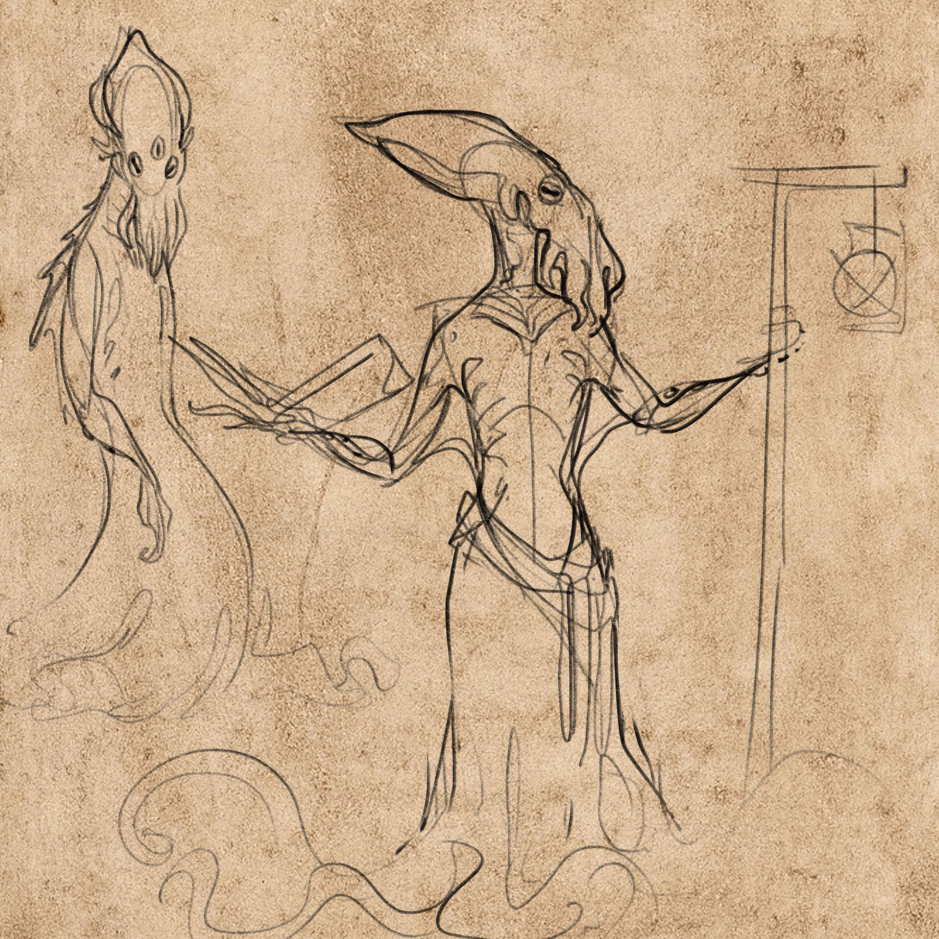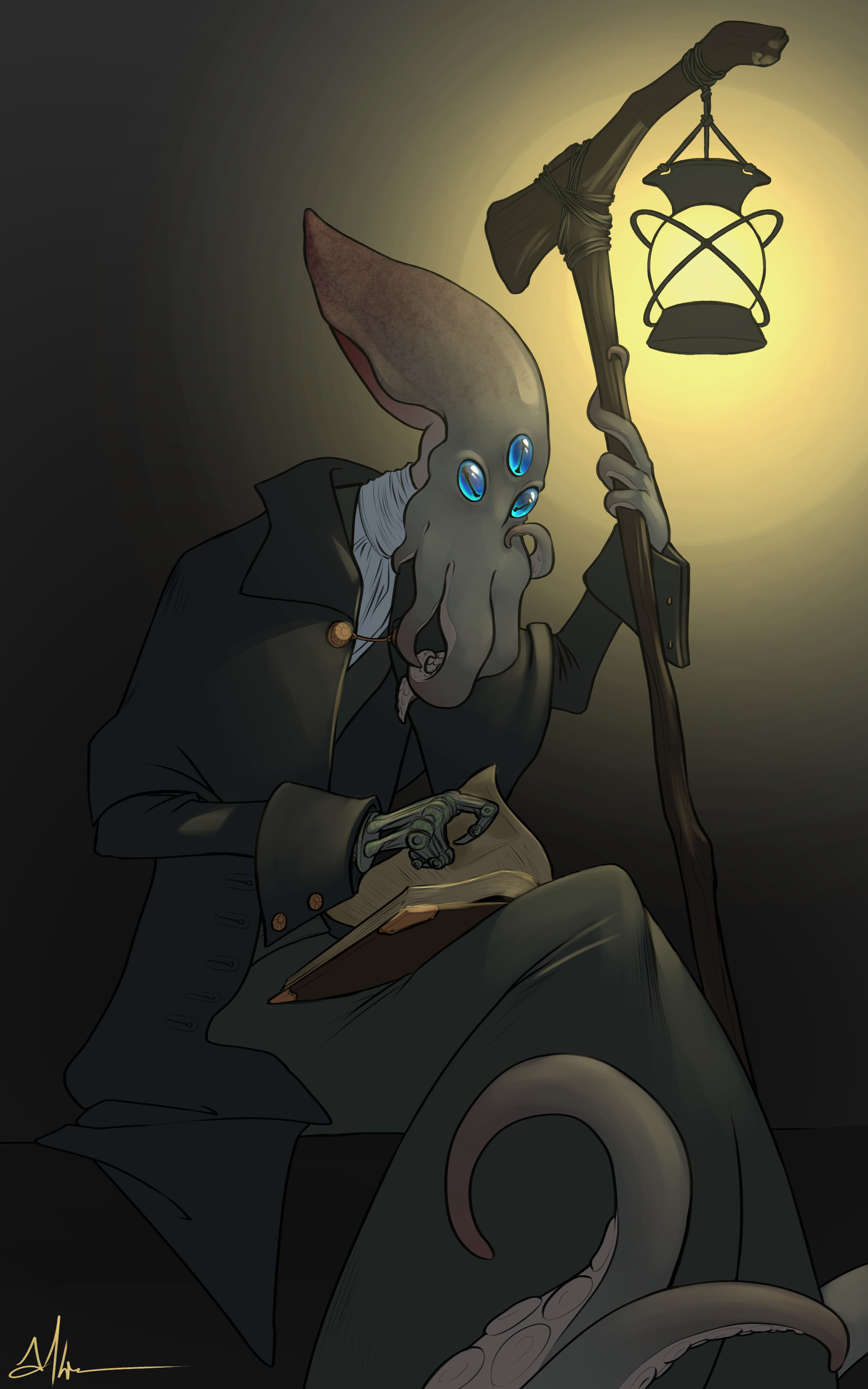Ceph
Basic Information
Anatomy
The Ceph are tall squid-folk. While their upper torsos are relatively humanlike, albeit rather gaunt and covered in a slick skin, their heads and lower bodies clearly display their animalistic inspiration. Cephan heads are highly elongated, arching back from their brows into long, mottled mantles with vestigial, decorative fins along the sides and tip. Their mouths are almost bird-like beaks, hidden from sight by a cluster of semi-prehensile tendrils, and they have three eyes spread in a wide, upward-pointing angle across the front and sides of their face. Cephan legs, such as they are, are a cluster of eight arms, each bristling with hook-tipped cups to allow them the utmost traction in any environment.

Ceph, Artist's Rendering by Mia Pearce
While natural squids are entirely boneless, the ceph require a fairly robust skeleton in order to remain upright on land. The limber lower arms’ bones are formed largely of cartilage, but the more humanoid portions of the body contain calcified bone throughout the spine, rib cage, upper arms, and front portion of the skull.
Ceph can come in a wide variety of colorations and patterns depending on their lineage, and some are even capable of changing color ever so slightly. As one might expect, they lack hair or the like, but variations in mouth-tendril length and mantle-fin shape fill much the same roles in terms of differentiating two similarly-colored individuals from one another.
Genetics and Reproduction
Ceph engage in marginally atypical sexual reproduction, after which the female will lay clutches of a dozen or so eggs in large, communal birthing pools. Of these eggs, only around half will actually hatch, with unhatched eggs being deposited in the swamp or oceans nearest the town, as an offering to nature itself for what bounty it spares.
Ecology and Habitats
Ceph require abundant moisture to remain comfortable in the short term and alive at all in the long term. This keeps them mostly confined to shorelines and wetlands, both of which Duwallen has in abundance. As they are capable of managing their water intake personally, they are not restricted by the water's salinity the way feral squids would be.
Biological Cycle
Ceph hibernate during the coldest parts of the winter, locking themselves indoors, storing what food they can, and essentially going catatonic for weeks at a time. In more urban areas, central heating and other comforts have begun to slowly eliminate the instinctual drive for hibernation, to the detriment of those who attempt to "rough it".
Additional Information
Facial characteristics
Cephan heads almost look like entire squids unto themselves at first glance, with a collection of tentacles around - and predominantly above - their beaks and a tall mantle and fin arcing up and away from it. Where they differ from regular squids most obviously is in their three eyes rather than only two. All of these eyes are almost entirely black, with a thing ring of iris around the very edges.
Geographic Origin and Distribution
A large majority of Ceph live in the marshes and swamps of northern Duwallen, but a fair few have spread out to other damp areas across the world in an effort to spread their kind around, so that the doom that befell Demeris might never risk slaughtering their entire species again.
Perception and Sensory Capabilities
Ceph are equipped with a clear, secondary lid on each of their eyes that can be closed to give them clearer vision underwater, as well as protect the eyes while submerged.
Symbiotic and Parasitic organisms
The Ceph were taken in by the Bufogren after the devastation of their species ages past. Since then, the two have lived together, melding their styles and cultures together in mutually beneficial ways.
Civilization and Culture
Naming Traditions
Cephan names are frequently centered around their meanings. Given names describe characteristics of their child - either current or hopeful in the eyes of the parents - while surnames tend to describe family occupations, crests, and the like. Occasionally an individual will include their place of origin in their name, particularly if they feel it reflects well on them as a point of pride, but it’s not legally recognized as a part of the name itself.
Beauty Ideals
Ceph judge personal beauty in two halves. The top half is expected to be slight and graceful, with emphasis in the face being placed on large eyes but small beaks. For the bottom half, bigger is better. Longer tentacles are simply more useful in a pragmatic sense, but the argument is often made that it makes the individual appear more 'grounded', a pun that has somehow stood the test of time.
Major Language Groups and Dialects
The language of the ancient Ceph was a form of Latin, which remains a significant influence on them to this day. However, after living alongside the Bufogren for centuries, their languages fused to create something that is more or less French. Exactly how a Ceph speaks their language is a good indicator for their class or personality. High class or snobbish folk will tend to speak a more ‘clean’ version of French, possibly even slipping Latin words or phrases (‘the old tongue’) from time to time. Commoners, or those who speak quickly or easily, are more likely to slip towards a more Creole end of the spectrum, falling in line with how many bufogren speak.
Culture and Cultural Heritage
After surviving near-extinction at the hands of a murderous demigod, the Ceph have come to depend greatly on a culture of community and trust. They treat their entire species as one large family, and adopt those who earn their trust - such as the Bufogren, who opened their cities to the refugees of that extinction event in the ancient past - into that family. They aren’t naive, and in fact they can often be somewhat slow to trust unfamiliar outsiders, but those who have earned the respect of a ceph would have to actively try to harm their reputation in order to lose it again.
Common Taboos
To speak ill of Demeris, its people, or its fate, or to make light of them without respect, is considered heinous. Speaking ill of the dead is already poor form, but to do it on such a massive and culturally relevant scale is abhorrent.
Pollution of the city's waterways is a signifcant health hazard to all citizens, and as such even minor acts such as littering or allowing chemicals or alchemical concoction to seep in to the city's water supply can range from fined offenses to outright jail-able crimes.
Common Myths and Legends
Mortimer - If he had a surname, it’s been lost to time. Once the Demise (local psychopomp) for the ceph in their capital of Demeris, he was driven to despair over the loss of his people and the part the gods might have played in it. Against the urging of his patron god Quietu, he took on the role of a reventant and has wandered the world ever since, seeking information on the seemingly unknowable being who nearly rendered the ceph extinct. In recent years, he has softened in his quest, allowing himself time to aid those around him who require it, most specifically the Rattenvolkern Fiona and her people, who also face extermination. Back in his homeland, Mortimer’s tale is a cautionary tragedy. He isn’t a hero, but rather a character to be pitied, having fallen to the siren’s song of vengeance.
Lifespan
220 - 300 years
Average Height
2 - 2.5m
Average Physique
The average Ceph is quite thin and frail on their upper halves, though the tentacles of their lower torso frequently harbor a significant amount of muscle. There are outliers who have managed to bulk up, but it takes a significant amount of effort to overcome their genetic predisposition towards thin, almost skeletal frames.

Dr. Gilbert, Cephan Runescribe by Yoko Weaver




Comments